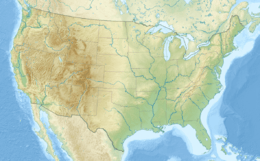Chilly Peak facts for kids
Quick facts for kids Chilly Peak |
|
|---|---|

Chilly Peak, west aspect, from Carne Mountain
|
|
| Highest point | |
| Elevation | 7,960 ft (2,430 m) |
| Prominence | 480 ft (150 m) |
| Isolation | 1.29 mi (2.08 km) |
| Geography | |
| Location | Chelan County Washington, U.S. |
| Parent range | Entiat Mountains North Cascades |
| Topo map | USGS Trinity |
| Climbing | |
| Easiest route | class 3-4 scrambling |
Chilly Peak is a tall mountain in Washington state, standing at about 7,960 feet (2,426 meters) high. It's part of the Entiat Mountains, which are a smaller group of mountains within the larger North Cascades range. You can find it in Chelan County.
This peak is one of the highest in Washington, ranking as the 192nd tallest out of the state's top 200 peaks. Its closest taller neighbor is a mountain called Ice Box, which is about 1.3 miles (2.1 kilometers) away to the northwest. Chilly Peak is also located about 2.5 miles (4 kilometers) south of some beautiful places called Ice Lakes.
The mountain is inside the Okanogan-Wenatchee National Forest. Water from rain and melting snow on Chilly Peak flows in two main directions. To the east, it goes into Ice Creek, which then joins the Entiat River. To the west, it flows into Rock Creek, which is part of the Chiwawa River.
Weather Around Chilly Peak
The area around Chilly Peak is a bit drier than places to its west. This is because it's located east of the main Cascade Mountains. In the summer, it can get warm, and sometimes there are thunderstorms.
Most of the weather systems that bring rain or snow start over the Pacific Ocean. They travel northeast towards the Cascade Mountains. When these weather fronts hit the tall peaks of the Cascades, they are forced to rise. As the air goes higher, it cools down and drops its moisture as rain or snow. This process is called Orographic lift.
Because of this, the North Cascades get a lot of rain and especially a lot of snow, particularly in the winter. Chilly Peak is so high that it can have snow on its slopes even in late spring and early fall. In winter, it can get very cold up there!
How Chilly Peak Formed
The North Cascades area, where Chilly Peak is located, has some of the most rugged and dramatic landscapes. You'll see sharp, jagged peaks, long ridges, and deep valleys carved out by glaciers. These amazing landforms and big changes in elevation are all thanks to geological events that happened millions of years ago. These events also created different climates and types of plant life across the region.
The story of how the Cascade Mountains formed goes back millions of years, to a time called the late Eocene Epoch. During this time, the North American Plate (a huge piece of Earth's crust) was slowly moving over the Pacific Plate. This movement caused a lot of volcanic activity, leading to the creation of many mountains. For example, Glacier Peak, a large stratovolcano (a cone-shaped volcano), started forming about 15.6 miles (25.1 kilometers) west of Chilly Peak during the mid-Pleistocene period.
Even more recently, over the last two million years, Earth experienced several ice ages. During these times, huge sheets of ice called glaciers grew and then melted away many times. As these glaciers moved, they scraped and shaped the land, leaving behind piles of rock and debris. The valleys you see today, which often have a "U" shape, were carved out by these powerful glaciers.
The combination of the Earth's crust pushing upwards (called uplift) and breaking apart (called faulting), along with the repeated action of glaciers, has created the tall peaks and deep valleys that make the North Cascades so unique and beautiful.



